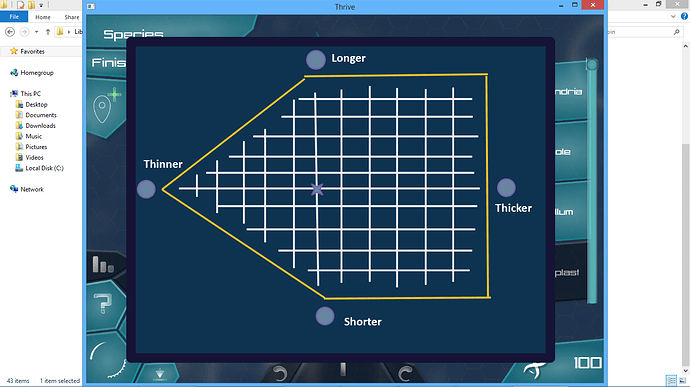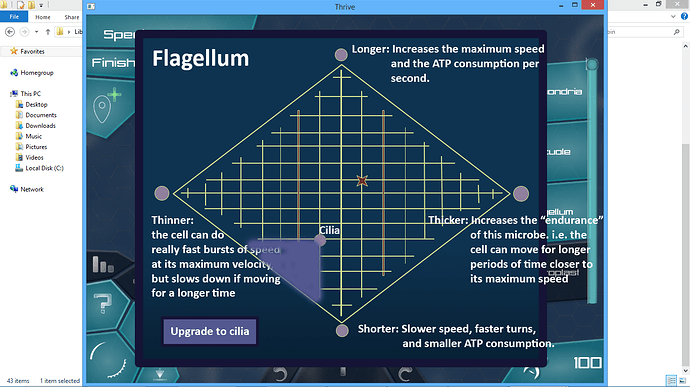We already have quite a few organelles in the game, and pretty soon we will have fantastic models for them (shout out to the graphics team), but there has been very little talk on what exactly happens when you upgrade organelles and even how you would go about upgrading them. Would there be an upgrade web, or would upgrading be a linear process? Would there even be such a thing as different stages for each organelle, or will it be a continuous process (so you upgrade statistics such as energy efficiency and light absorbance for the chloroplast)?
In this thread, I hope that we can answer these questions and decided on the advantages and disadvantages of different organelle upgrades. However, this thread should only focus on process/storage/movement organelles since agents is a completely different topic that deserves its own thread.
Anyway, here are the currently planned organelles, taken directly form the GDD (thanks @Oliveriver) :
- Nucleus – The nucleus is a special case organelle. It’s part of the
player’s microbe from the start of the game (as they play as a
eukaryotic cell) and cannot be moved or removed in the editor. Having
a nucleus allows for replication, compound control and simple
behavioral patterns, which, as major tenets of the gameplay system,
must always be available to the player from the start. The nucleus is
an internal organelle which the rest of the cell is built around. It
isn’t listed in the editor organelle list as only one can ever exist
inside a cell. When a cell dies, its nucleus has a small chance of
remaining intact. Other cells which consume the nucleus gain more
available Mutation Points for the next editor session or CPA-mandated
mutation. - Mitochondrion – Mitochondria perform aerobic respiration within
cells, taking one glucose molecule and six oxygen to produce six
water, six carbon dioxide, and energy. Energy is represented by ATP,
so as far as the player is concerned, mitochondria produce ATP (the
complex partial steps involved in respiration aren’t modeled, only
the overall inputs and outputs). Though mitochondria can be placed in
the editor from the start of the game and the player even begins with
at least one mitochondrion, additional mitochondria can still be
obtained for free by endocytosis of free-living respiring bacteria
(~1 in 100 chance). As with all organelles obtained this way, newly
assimilated mitochondria are initially unique to the player’s
individual, but entering and exiting the editor with the same
mitochondria intact adds it to all members of their species. - Flagellum – External organelle used for movement. A flagellum is a
long, tail-like organelle which rotates to drive a cell forward.
Flagella, along with cilia, allow cells to fight against water
currents which would otherwise take them in potentially unwanted
directions. Flagella only add propulsion in a single direction, and
multiple flagella on the same side of a cell increase a cell’s
ability to move in that direction. Flagella can be placed as new
organelles from the beginning of the game. They do not use or produce
compounds but do use up relatively large amounts of ATP. - Cilia – Cilia are smaller versions of flagella, but cover the entire
cell as a periphery organelle choice. Cilia produce small
omni-directional movement for less ATP than flagella. Cilia are
available from the beginning of the game, and can be upgraded to
lamellipodia. The movement speed generated by cilia can also be
upgraded. - Cytoplasm – Cytoplasm is different from all organelles in that it
determines a cell’s overall structure. In the editor, other
organelles must be placed in cytoplasm. Cytoplasm does perform some
simple chemical reactions and it’s the medium through which ATP is
transferred. It’s available from the beginning of the game and is
relatively cheap. Each hex also consumes a very small amount of ATP
for osmoregulatory processes, so larger microbes will need more
energy to function. - Vacuole – Internal organelle used for compound storage. Each vacuole
has a maximum agent capacity based on weight (so more oxygen
molecules can fit in a vacuole than glucose, for instance), and
generally compounds will be flowing in and out of a vacuole
simultaneously. Larger vacuoles (there are many different size
varieties in the editor, larger variants costing more Mutation
Points) also provide some cell rigidity, especially when combined
with a cell wall. Vacuoles are available in the editor from the start
of the game, and the player determines which compound or agent will
be stored in each. - Chloroplast – Photosynthesizing internal organelle. Chloroplasts take
in water and carbon dioxide to produce glucose and oxygen, using up
light energy (therefore they have a greater yield in environmental
light spots). Chloroplasts are locked in the editor at the beginning
of the game, as the player must assimilate a free-living
cyanobacterium to gain one free chloroplast and add more in the
editor. Cyanobacteria are only found in well-lit areas, such as light
spots or certain biomes. - Thermoplast – Thermoplasts work in exactly the same way as
chloroplasts, instead using heat to create glucose and oxygen via
thermosynthesis. This makes them a more viable option in the
hydrothermal vent biome than chloroplasts, but since thermoplasts are
fictional, if the player has checked the LAWK toggle neither they nor
NPC species will be able to evolve thermoplasts. To unlock
thermoplasts in the editor, the player must engulf a free-living
sessile bacterium, generally found in heat spots or near hydrothermal
vents. - Cell Wall – Periphery organelle. The player’s cell can evolve a cell
wall in multiple steps. Cell walls provide extra strength and
protection from some agent types, engulfing and predatory pili, as
well as preventing death by osmolysis. However, the latter is only
possible if a full cell wall has evolved. The others increase in
effectiveness with each upgrade step, so a thicker cell wall will be
able to stop longer pili. With a complete or near-complete cell wall,
the cell’s visuals will change. Its membrane will no longer be so
flexible, instead trapped within a procedurally generated wall layout
based on the hex grid design. The cell wall is unlocked as soon as
the player unlocks chloroplasts or thermoplasts, and consumes and
produces no compounds or ATP. Unlike other periphery organelles, cell
walls prevent the placement of any external organelles – cell walls
cannot be chosen unless all external organelles have been removed,
except agent secretors (their icon is grayed out and a tooltip
message informs the player of the reason why). Cell walls therefore
prevent agent secretors being upgraded to pili. - Predatory Pilus – External organelle used for attack. Effectively an
offensive “spike”, a pilus can be used to pierce the membranes of
other microbes, killing them and releasing their compounds into the
environment. Pili are unlocked from the start of the game, and can be
upgraded by having their length extended. Pili also have all the
functions of an agent secretor and are edited in a similar manner
with hotkeys and tied agents. Pili are ineffective against cell walls
and are relatively heavy, making motility difficult for
pilus-wielding cells. They’re only available by upgrading an agent
secretor, but can be cross-graded back into an agent secretor. - Bioluminescent Organelle – Unlocked once the player assimilates a
bioluminescent bacteria in the same manner as chloroplasts, or by
upgrading a vacuole when a bioluminescent agent has been developed.
Bioluminescent organelles will glow in-game, providing light in dark
locations by consuming ATP. They provide very little gameplay use for
an experienced player, but they can be used in a symbiotic
relationship with other microbes which have chloroplasts, effectively
transferring energy between the two as chloroplasts use the light
energy to photosynthesize even in dark locations. - Endoplasmic Reticulum – Allows for protein and agent synthesis.
Available from the start of the game, including one present in the
starting cell by default. Consumes ATP. - Golgi Apparatus – Required for agent secretion of any type, available
from the beginning of the game, and comes with the starting cell.
Consumes ATP.
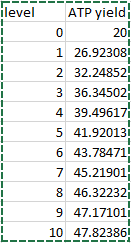
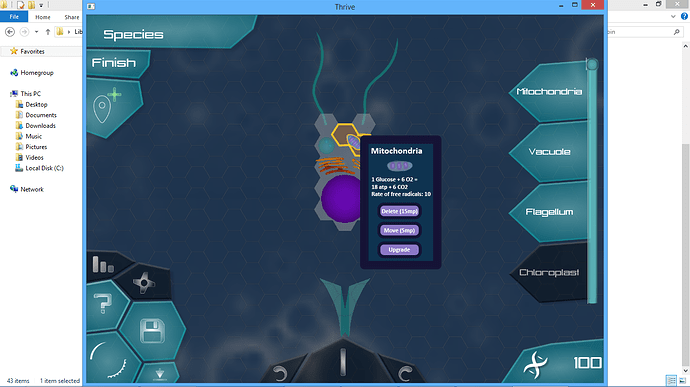
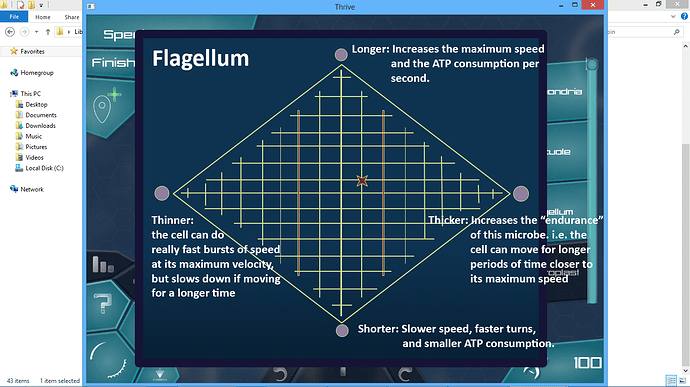
 Obviously, you cannot simultaneously make a flagellum longer and shorter, but it offers for more subtle differences. You cannot make a very long and thin flagellum, you have to strike a good balance between these two traits, depending on your lifestyle (I just pulled this comparison out of my head). But let’s say you want to at the same time be able to make a thick and long flagellum (you are just against short and long flagella because they break off or something), you could make a crazy shape like below:
Obviously, you cannot simultaneously make a flagellum longer and shorter, but it offers for more subtle differences. You cannot make a very long and thin flagellum, you have to strike a good balance between these two traits, depending on your lifestyle (I just pulled this comparison out of my head). But let’s say you want to at the same time be able to make a thick and long flagellum (you are just against short and long flagella because they break off or something), you could make a crazy shape like below: